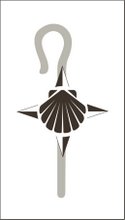May 11th, 2007
As I write this posting, I am still filled with emotions that are raw yet tender. What I saw, heard, felt, and was moved by was not in the travel books I read before I went on this trip.
Bethlehem, which is only a few miles down the road from Jerusalem proper, is a walled-off prison, a.k.a., Palestinian refugee camp. "O little town of Bethlehem how still we see thee lie," does not exist anymore. The high grey wall that encircles this Holy City is horrendous. I call it a snake that is trying to kill off life in this City.
Henry drove us to one of the few entry places into the walled-off city. While we went through numerous scanners, x-ray machines, and gates while being televised, all in a few minutes, it can take a Palestinian hours to go through the very same thing. Henry could not come with us because he is Israeli.
Our new friend Elias Ghareeb met us on the other side of the wall. A Greek Orthodox Palestinian, Elias had just returned from vacation. Instead of flying out of Ben Gurion airport down the road, he has to go to Amman, Jordan and fly out of Jordan because he is Palestinian.
First place to go was Manger Square. Along the Church of the Nativity you can see the bullet holes from the battle that went on in this city a few years ago. Instead the Church we saw the beauty of the mosaic floors that Helena had built, along with the icons of the Crusaders. Underneath the main floor, in a small alcove, was the spot where Jesus was born, and the spot that the cradle inhabited. Hundreds of pilgrims filled the tight space. Elias reminded us that most people lived in small caves or grottoes, which explained the tight space that felt like a rocky enclosure.
Near this site is the place that St. Jerome wrote the Vulgate version of the Bible near the chapel of St. Joseph, Jesus' father. Again, like so much in Jerusalem, we saw the Russian and the Greek Orthodox sections, the Roman Catholic section, and the Coptic sections of the Church. Protestantism does not have much of a hold on these Holy sites.
Picking up Elias' car outside the Milk Grotto (where Mary's milk touched the floor of the cave, making the entire cave white), we went to the Palestinian Refugee Camp. We specifically spent time at the Lajee Center of the Aida Refugee Camp. We heard of the stories of oppression of the Palestinian people, and went to the top of the building to see the snaking, meandering wall that is dividing the people from the land. Within Bethlehem, the medical, educational, and civil services are being constricted. Life is tense among and in families. Israel is not building a wall along the Green Line (an agreed upon line between the Palestinian people and Israel), but is taking whatever land they want.
We talked a great deal about the oppression of the Palestinian people. The wall is meant to "protect the Palestinian people" says Israel, but the Palestinian people are growing restless within these walls, and the days of the next intifada are coming. Over lunch at the Grotto Restaurant we looked at where Elias hopes to move to, though it may be torn down in order for the Israeli's to build their wall.
We sang "Gloria in Excelsis Deo" in the Shepherd's Chapel, with Elias, a group of Filipino nuns, and ourselves. After we picked up some gifts for people at home at a beautiful gift store, and tried to visit the Greek Orthodox Church in Bethlehem, Elias turned me on to kanahfay (sp?), a sweet dessert that is high on my list of "must haves."
We left Elias that day angry about the sense of victimization that is going on among the people, and lost in the question: why would a people who were once victims now turn around and become the victimizers of oppression?
Pilgrim peace, Brett
Subscribe to:
Post Comments (Atom)


No comments:
Post a Comment